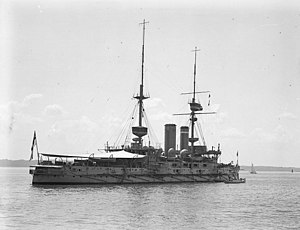Formidable-class battleship

HMS Implacable at Spithead in 1909.
|
|
| Class overview | |
|---|---|
| Name: | Formidable/London/Queen-class battleship |
| Operators: |
|
| Preceded by: | Canopus class |
| Succeeded by: | Duncan class |
| Subclasses: |
|
| Built: | 1898–1904 |
| In commission: | 1901–19 |
| Completed: | 8 (3 Formidable class, 3 London class, 2 Queen class) |
| Lost: | 3 (2 Formidable class, 1 London class) |
| Retired: | 5 (1 Formidable class, 2 London class, 2 Queen class) |
| General characteristics | |
| Class and type: | Formidable, London, and Queen classes |
| Type: | Pre-dreadnought battleship |
| Displacement: |
|
| Length: | 431 ft (131.4 m) overall |
| Beam: | 75 ft (22.9 m) |
| Draught: |
|
| Propulsion: |
|
| Speed: | 18.0 kn (33.3 km/h); on trials Formidables averaged 18.2 knots |
| Complement: |
|
| Armament: |
|
| Armour: | |
The Royal Navy's Formidable-class battleships were an eight-ship class of pre-dreadnoughts designed by Sir William White and built in the late 1890s. The class is often further divided into a separate London class, and the London class sometimes is divided further into a separate Queen class. Alongside the King Edward VII class, they were the largest class of battleships built, with eight complete vessels.
The Formidables were similar in appearance to and had the same armament as the Majestic and Canopus classes that preceded them. The Formidables are often described as improved Majestics, but in design they really were enlarged Canopuses; while the Canopus class took advantage of the greater strength of the Krupp armour employed in their construction to allow the ships to remain the same size as the Majestics with increased tonnage devoted to higher speed and less to armour without sacrificing protection, in the Formidables Krupp armour was used to improve protection without reducing the size of the ships. The Formidables thus were larger than the two preceding classes, and enjoyed both greater protection than the Majestics and the higher speed of the Canopus class. The Formidables' armour scheme was similar to that of the Canopuses, although, unlike in the Canopuses, the armour belt ran all the way to the stern; it was 215 feet (66 m) long and 15 feet (4.6 m) deep and 9 inches (229 mm) thick, tapering at the stem to 3 inches (76 mm) thick and 12 feet (3.7 m) deep and at the stern to 1.5 inches (38 mm) thick and 8 feet (2.4 m) deep. The main battery turrets had Krupp armour, 10 inches (254 mm) on their sides and 8 inches (203 mm) on their backs.
The Formidables improved on the main and secondary armament of previous classes, being upgunned from 35-calibre to 40-calibre 12 inch (305 mm) guns and from 40-calibre to 45-calibre 6 inch (152 mm) guns. The 12 inch guns could be loaded at any bearing and elevation, and beneath the turrets the ships had a split hoist with a working chamber beneath the guns that reduced the chance of a cordite fire spreading from the turret to the shell and powder handling rooms and to the magazines.
...
Wikipedia
